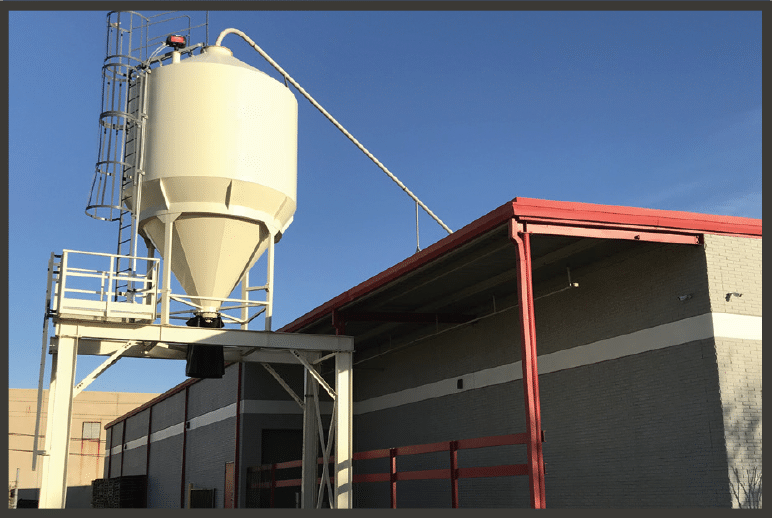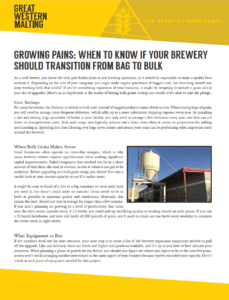Growing Pains: When to Know if Your Brewery Should Transition from Bag to Bulk
As a craft brewer, you know the vital part barley plays in any brewing operation, as it would be impossible to make a quality beer without it. Depending on the size of your company, you might make regular purchases of bagged malt, but how long should you keep working with that model? If you’re considering expansion of your business, it might be tempting to include a grain silo in your list of upgrades. Here’s an in-depth look at the reality of buying bulk grains to help you decide if it’s time to take the plunge.
Cost Savings
For many breweries, the decision to switch to bulk malt instead of bagged products comes down to cost. When buying bags of grain, you will need to arrange more frequent deliveries, which adds up to a more substantial shipping expense every year. By installing a silo and storing large quantities of barley at your facility, you only need to arrange a few deliveries every year, and that can cut down on transportation costs. Bulk malt usage also typically reduces one’s labor costs when it comes to preparation for milling and mashing in. Spending less time laboring over bags saves money and means your team can be performing other important tasks around the brewery.
When Bulk Grain Makes Sense
Small businesses often operate on razor-thin margins, which is why many brewery owners express apprehension when making significant capital improvements. Failed companies that reached too far in a short amount of time litter the road to success, so this is when it can pay to be analytical. Before upgrading to a bulk grain setup, you should first take a careful look at your current capacity to see if it makes sense.
It might be easy to think of a silo as a big container to store malt until you need it, but there’s much more to consider. Grain needs to be as fresh as possible to maintain quality and consistency. Generally, this means the malt should not stay in storage for longer than a few months. If you aren’t planning on growing to a level of productivity that turns over the silo’s entire capacity every 8-12 weeks, you could end up sacrificing quality or wasting money on stale grains. If you run a 20-barrel brewhouse and your silo holds 48,000 pounds of grain, you’ll need to crank out one brew every weekday to consume the entire stock in eight weeks.
What Equipment to Buy
If the numbers work out for your business, your next step is to make a list of the brewery expansion equipment needed to pull off the upgrade. Like any industry, there are lower and higher-end products available, and it’s up to you how to best allocate your resources. When planning a phase of growth for the future, you should also figure out where you expect to be in the next few years, so you aren’t stuck arranging another investment in the same aspect of your business because you’ve exceeded your capacity. Here’s a look at each piece of equipment needed for this project.
Grist Mill
Your first step should be to buy a grist mill, as this is a piece of equipment that can save your brewery money even if you aren’t ready to make the jump from bag to bulk. By milling the grain yourself, you can save a few cents per pound, which quickly adds up over the course of a year. When choosing between models, try to buy the best model your business can afford, as you want to maintain the maximum level of quality across every batch. Budget devices deliver an inconsistent crush, which can affect your efficiency during brewing operations.
Conveyance System
Next up should be a conveyance system to move your grain from one place to another. Even if you’re still using bags, having a conveyance system can carry your malt from the grist mill into your hydrator or mash tun. Conveyance equipment is an area where quality matters, as inferior machinery can damage your barley during its journey. Avoid hollow-core augers, as they can cause a backflow that damages your malt, and are only useful for short, horizontal runs. Try to invest in a chain disk or flexible auger for more gentle handling.
Grist Case
A grist case is another useful piece of equipment, as it provides a holding tank between the mill and your hydrator. Instead of milling directly into your brewhouse over time, this extra piece of equipment allows you to get everything into the warm water at once, which will shorten your brewing day and help maintain consistent temperatures.
Silo
The silo should be the last thing purchased when upgrading in phases but is essential if you’re switching to a bulk grain setup. Logistically, silos should be placed as close to the mill as possible to shorten the distance of your conveyance system. Pay attention to local building codes to make sure you can pass inspection, as you’ll need to comply with restrictions on height, seismic safety, and design of the concrete pad and footers.
Concerning silo design, a straight-wall model is best, but it will cost more than a bolt-together unit. If you live in an area with high moisture, it is likely worth investing in a straight-wall model, as the lack of seams between sections prevents leaks and helps keep grain dry. Also, make sure it can hold 20 percent more than a full 48,000 pound truckload of malt, and that it has adequate access for filling, cleaning, and inspection.
Invest in Your Business
These are some of the significant things to consider before switching away from bagged malt but don’t hesitate to reach out to other local breweries for additional advice. Quality malt is crucial to making great beer, so be sure you’re making the right decisions to keep your barley safe. Once you’ve installed that beautiful new silo, you can trust Great Western Malting to help keep it full. To learn more about our products or to arrange a grain delivery, give us a call today at 360-693-3661.






